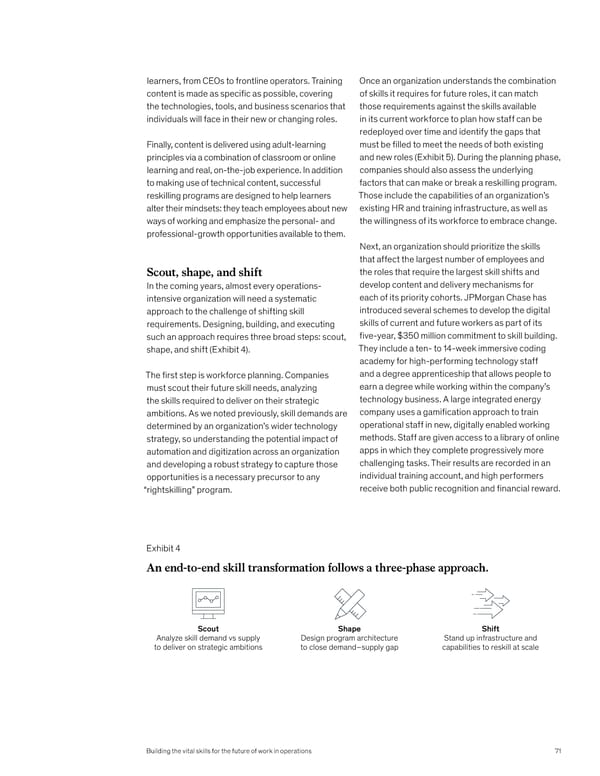learners, from CEOs to frontline operators. Training Once an organization understands the combination content is made as specific as possible, covering of skills it requires for future roles, it can match the technologies, tools, and business scenarios that those requirements against the skills available individuals will face in their new or changing roles. in its current workforce to plan how staff can be redeployed over time and identify the gaps that Finally, content is delivered using adult-learning must be filled to meet the needs of both existing principles via a combination of classroom or online and new roles (Exhibit 5). During the planning phase, learning and real, on-the-job experience. In addition companies should also assess the underlying to making use of technical content, successful factors that can make or break a reskilling program. reskilling programs are designed to help learners Those include the capabilities of an organization’s alter their mindsets: they teach employees about new existing HR and training infrastructure, as well as ways of working and emphasize the personal- and the willingness of its workforce to embrace change. professional-growth opportunities available to them. Next, an organization should prioritize the skills that affect the largest number of employees and Scout, shape, and shift the roles that require the largest skill shifts and In the coming years, almost every operations- develop content and delivery mechanisms for intensive organization will need a systematic each of its priority cohorts. JPMorgan Chase has approach to the challenge of shifting skill introduced several schemes to develop the digital requirements. Designing, building, and executing skills of current and future workers as part of its such an approach requires three broad steps: scout, five-year, $350 million commitment to skill building. shape, and shift (Exhibit 4). They include a ten- to 14-week immersive coding academy for high-performing technology staff The first step is workforce planning. Companies and a degree apprenticeship that allows people to must scout their future skill needs, analyzing earn a degree while working within the company’s the skills required to deliver on their strategic technology business. A large integrated energy ambitions. As we noted previously, skill demands are company uses a gamification approach to train determined by an organization’s wider technology operational staff in new, digitally enabled working strategy, so understanding the potential impact of methods. Staff are given access to a library of online automation and digitization across an organization apps in which they complete progressively more and developing a robust strategy to capture those challenging tasks. Their results are recorded in an opportunities is a necessary precursor to any individual training account, and high performers “rightskilling” program. receive both public recognition and financial reward. Web <2020> Exhibit 4 Exhibit <4> of <5> An end-to-end skill transformation follows a three-phase approach. An end-to-end skill transformation follows a three-phase approach. Scout Shape Shift Analyze skill demand vs supply Design program architecture Stand up infrastructure and to deliver on strategic ambitions to close demand–supply gap capabilities to reskill at scale Building the vital skills for the future of work in operations 71
 What Now? Page 72 Page 74
What Now? Page 72 Page 74